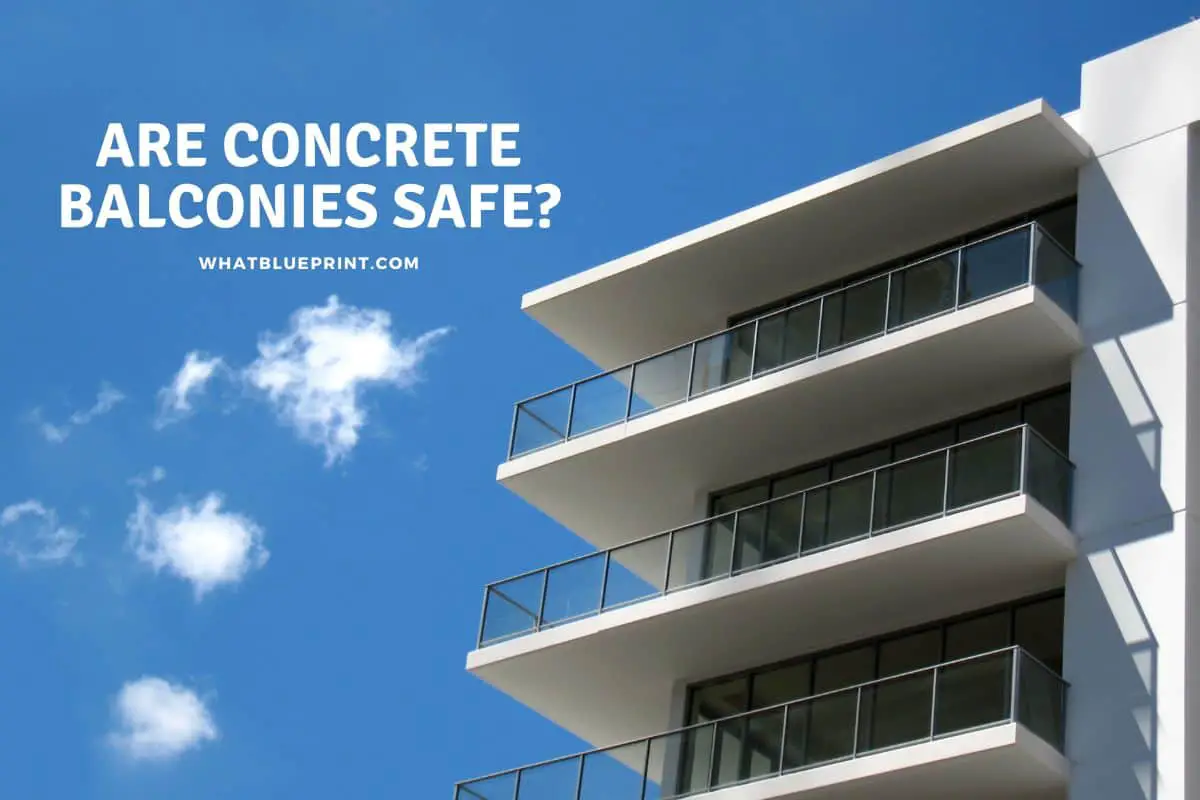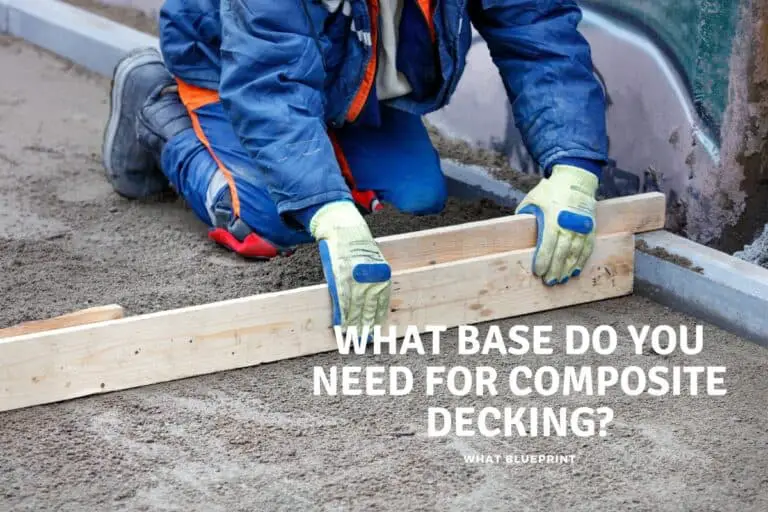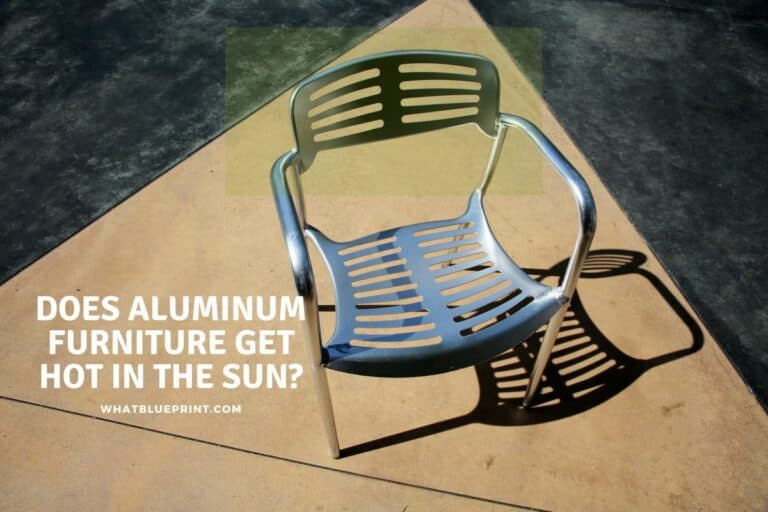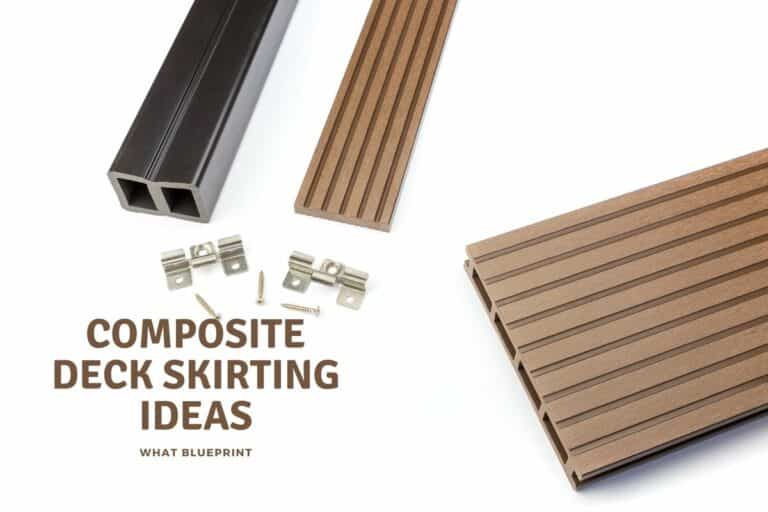Are Concrete Balconies Safe?
Concrete balconies are safe and durable for the most part, and extending your living area with a balcony is a great idea. However, you will need to ensure that it is constructed well and kept in shape through routine maintenance.
Numerous companies, residences, and apartments worldwide include concrete balconies due to their solidity, safety and durability and they can last for decades. Safety will only become a problem if builders scrimp on the quality of building materials or homeowners perform little to no maintenance.
Some things you can do to expand the longevity of your concrete balcony are to add waterproofing which will increase its useful life. Find out below what else impacts the safety of concrete balconies.
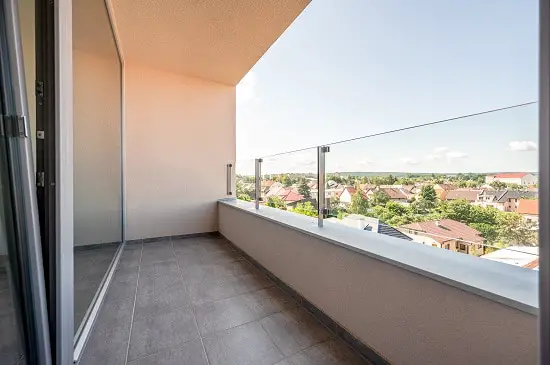
Concrete Balconies Can Be Safe
Because of its high compressive strength, concrete is the best cost-effective material for supporting buildings, structures, and balconies. But if the concrete is such a good material for balconies, why are they sometimes unsafe? Let us understand first what makes concrete strong and where its weaknesses lie.
What Is Meant By Compression Strength In Concrete?
Concrete is extremely strong and can handle heavy loads. Many individuals on a balcony will not damage the concrete because of their weight. Think of standing on a large rock vs. standing on a mattress. Imagine a massive crowd of people on the rock. Will they be able to squish the rock? Of course not? But place those same persons on the mattress, then they will squish that mattress into a fin layer.
That is what we mean by compressive strength. Because of how it is mixed, concrete can withstand a lot of pressure. When cured, a mortar made of crushed stone and cement hardens into a sturdy construction. But unfortunately, there is a problem with concrete that comes with this same binding method. The crushed rocks do not become part of the cement mix.
The cement mix suspends the stones in place, but there are tiny air bubbles around the rocks. So construction workers use vibrating tools to vibrate the air pockets out as much as possible from between these rocks. But unfortunately, they cannot get all the air out; this is the concrete slap’s weakness.
Applying pressure to the concrete slab compresses these little bubbles, but the concrete can withstand that pressure. However, when you pull on the concrete, air bubbles become more prominent, and cracks appear. The more you pull, the weaker the binding mix becomes to the point where it cannot hold the tension anymore, and it snaps.
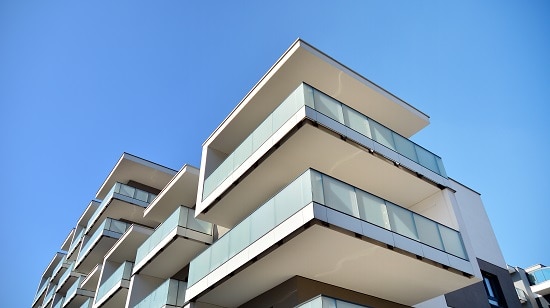
What Is Meant By Tensile Strength In Concrete?
You will often hear that concrete does not have tensile strength, which means it cannot withstand pulling tension. But how are you pulling on the slab, you may ask? Concrete balconies extrudes from the building’s side, and the further you move away from the building edge, the more your weight will pull the concrete down towards the ground.
Adding more people on that spot increases the pulling pressure on the wall until it cannot handle the strain anymore, which is when the concrete slab breaks away. Fortunately, there is an excellent answer to this problem called reinforcement. To reinforce the concrete, contractors will add steel rods called rebar into the concrete.
Steel has tremendous tensile strength. So combining steel with concrete creates a sturdy and solid structure. When you visit a construction site, just before they pour the concrete slab, you will see a steel mesh made from rebar. After adding the concrete slurry to the rebar mesh, it takes at least 21 days to cure.
What Are The Problems With Steel Rebar In Concrete?
Longer, cantilevered concrete balconies require less support when erecting balcony slabs since the steel rebars are more durable. In addition, building contracts may move more rapidly, boosting construction businesses’ productivity since thinner slabs are laid.
Although concrete is a highly resilient building material and can last for centuries when left unreinforced, we understand that it is not an option for modern building methods, especially balconies.
Iron is the primary component of steel, and one of iron’s unchangeable characteristics is that it rusts.
For example, the Pantheon in Rome, one of the biggest unreinforced concrete domes in the world, is still in fantastic shape after 1,900 years. Yet many concrete bridges, highways, and buildings built in the last century are in disrepair. The main distinction is the current use of rebar, or hidden steel reinforcement, in the concrete.
Even when steel gets concealed in the concrete, it can still rust. Rust may cause the rebar to swell by up to four times its original size, creating fractures from within.
While the compressive strength of the balcony lies in the concrete, the tensile strength comes from the rebar. Cracks might appear in the concrete, and water can cause corrosion in the rebar. Deterioration of the rebar will reduce the strength of the concrete balcony. Regular checks and maintenance can prevent the collapse of the balcony. Look for rust stains, concrete pieces chipping off, cracks, etc.
Loose railings can cause water to seep into the rebar rings, and the rebar starts to rust. Therefore it is essential to look for marks, salt stains (if living close to the ocean), cracks, and paint that may seem like cosmetic issues. However, they might be signs of more significant structural problems.The 3 Main Types Of Concrete Balconies
The cantilever concrete balcony: These concrete balconies get built so the balcony extends from the building’s face without any additional support. The weight and imposed loads are supported by cantilevering the structure off the wall. Cantilever concrete balcony doesn’t need any anchors, construction to lean on, or steel cables holding it up. It would be better if you had a lot of scaffolding during construction to support the drying process.
Steel plank concrete balconies: These balconies use anchor bolts that you fix to the wall structure of a building, and the edge of the balcony must stand on concrete or masonry pillars for support. The scaffolding needed for this concrete balcony is not that much during construction.
Glide-on concrete balconies: These newer and modern techniques for concrete balconies are built offsite. The balconies are precast in a construction yard and then brought to the site for installation. This method makes it much faster and easier to install. The cast is then anchored with bolts to steel bars extruding from the building. Steel cables are required to hold the concrete balcony upright.
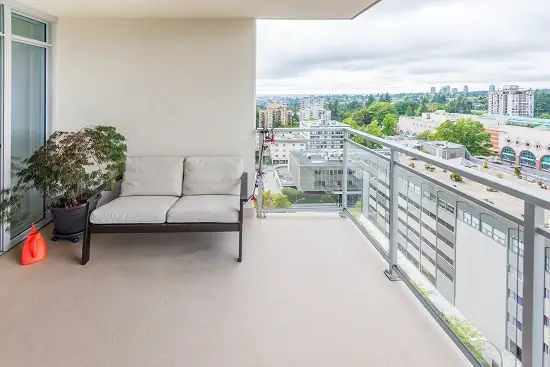
Waterproofing And Sealing Your Concrete Balconies
As mentioned above, rust is the biggest threat to a reinforced concrete balcony. Water penetrating the structure will undoubtedly cause the rebar to rust, and to prevent that, you need to waterproof and seal your slab. Hopefully, when your balcony got constructed, they did extensive waterproofing, but if that is not the case, you will need to do it to prevent problems later
You have a few options for waterproofing your concrete balconies. Various silicone- and water-based concrete sealants are available on the market today. Both have advantages and disadvantages to weigh before making a purchase. You can also paint or tile your concrete slab for extra protection. Efficient waterproofing with specialized materials allows you to do extensive repairs on cracks.
Sealants Based On Silicone
Silicone-based sealers are more robust and expensive than water-based sealers, but they last longer and require less frequent reapplication. In addition, silicone-based sealers, unlike water-based sealers, can withstand an unexpected rain shower the day after they’ve been applied to your concrete balconies.
Water-Based Sealants
Because they are easier to clean up in the event of a spill, water-based sealers are more convenient than silicone-based sealers. In addition, the sealer may be diluted and washed away with more water while it is still wet and curing if you want to remove any spills. You will, however, require as many as two applications a year in regions with a lot of humidity and rain.
Painting Your Concrete Slab
After washing and cleaning, your concrete balconies, apply a thin layer of nonslip UV-resistant paint and follow that with a waterproofing finish. Make sure you seal all around the edges and bottoms of the railings too.
Tiling The Concrete Floor
Many people opt to tile their balconies, which is an excellent enhancement of value to add to your home. However, one thing to consider is the additional weight it may add to the structure. You can then finish the tile job with a waterproof grout and add silicone or water-based sealant on top of the tile.
Safety When Sealing Your Concrete Balconies
Wear goggles to avoid splashing yourself in the eye when using chemicals to wash and seal your concrete balcony thoroughly. Wear protective clothes, shoes, and gloves to protect your skin from chemical overspray and splashes. A great tip is to wear kneepads when working so close to the ground.
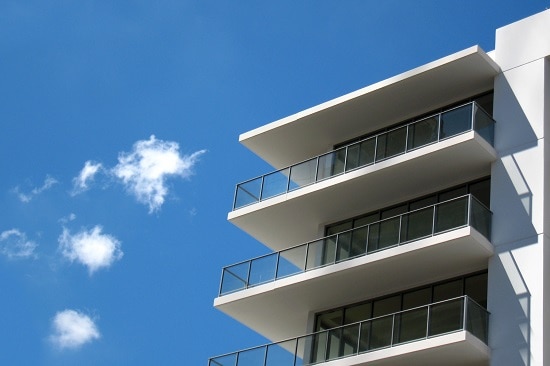
Balcony Load Limits
The type of concrete balconies, the thickness of the concrete slab, and the design of rebar in the slab make a difference in load-bearing. Usually, small groups of 3 to 5 people use a balcony, but the weight of all the people, BBQ grill, pot plants, tables, chairs, etc., must be kept in mind when you think, is it going to be safe? If designed and constructed correctly, concrete balconies can at least hold 50-100 lbs. (22-45 kg) per square foot.
Can A Concrete Balcony Collapse?
Yes, Five hundred(500) people are injured yearly, and an estimated 50% of 40 million decks, balconies, patios, etc., in the U.S. are not built to the building code. Therefore lawmakers have created specific codes to help regulate decks, balconies, patios, etc. This followed the collapse of some balconies over the last few years.
Unfortunately, the lack of enforcement and routine checks allows dangerous concrete balconies to deteriorate further.
Balcony Safety Guidelines
There are some balcony safety issues outside of maintenance to keep in mind. Watching your balcony furniture placement in a home with young children and pets would be best. Furniture near the balcony railing could allow kids or pets to climb above the top of the barrier. Keep fixtures and other items away from the balcony railings, or don’t allow your pets or young ones on the balcony unless an adult can supervise.
If possible, do not construct balcony railings with horizontal posts since children can easily climb these railings and fall over the edge.
Teach children the dangers of the balcony if not used correctly. Discourage them from playing on or around the railing. Teach them to be safe when they go out on the balcony. If you have plants and other objects on your balcony railings, secure them tightly, so they don’t fall from the balcony and injure someone or damage something below.
Balcony Safety Inspections Prevent Tragedies
Safety inspections are vital to hung, stacked, cantilever, or high-rise concrete balconies to ensure the health and safety of residents. Safe balconies have less risk of children, pets, and objects falling through the spaces in the railings.
Missing pieces of concrete balconies are often visible from below. It is essential to know that a small piece of concrete can kill you if it should fall on your head. The balcony has railings(Balcony’s railings are usually around 36” to 42” from the balcony floor.) to keep tenants and items safe and secure. We have more information on balcony railing heights here.
Professionally Inspect Your Concrete Balcony Every 9 Years
You should know that Health and Safety will close down unsafe concrete balconies if they are deemed hazardous to you or the general public. Qualified inspectors should inspect concrete balconies. This engineer will pull a chain or knock on the concrete with a small hammer to listen for any loose concrete flaking or delamination.
After inspection of the concrete balcony, the inspector advised that the elevated element poses an immediate threat to the occupants and the general public. The inspector reports to the association upon completion of the report within 15 days. Upon receiving the report, the association shall take immediate preventive measures, including preventing the occupant’s access to the elevated concrete balconies.
After repairs are complete, the inspector must approve repairs to the local enforcement agency. This proactive approach results in a safer haven for tenants and the general public.
Who Are The Experts You Can Contact For Help?
People with skills and experience with concrete balconies can do your inspections and provide you with the correct means of keeping and making your concrete balcony a safe place. Relevant experts include people like licensed builders, building surveyors, structural engineers, building inspectors, and architects.
Suppose you get an expert to conduct your concrete balcony inspections and advise you on how to fix them. Ensure they have the relevant license or registration, skills, and qualifications.
What If You’re Buying A New Home With A Balcony?
When buying a home with a concrete balcony, you may need to have it inspected. Get the approved plans from your local council and have the inspector make sure any buildings, renovations, or additions have been made with the required planning and building approvals. If you buy a house with an unapproved concrete balcony or other unapproved buildings and something goes wrong, you could be held liable.
We also go into toughened and laminated glass differences and choices here on the site if you are still exploring your options.
We also have other safety articles on balconies on the site you can check out below.
Conclusion
Concrete is the most cost-effective material for sustaining buildings, structures, and balconies due to its solid compressive strength. When you visit a building site, you will notice a steel mesh composed of rebar right before the concrete slab is poured. Because steel rebars are more robust and longer, cantilevered balconies require less support when installing balcony slabs.
There are no anchors, construction to lean on, or steel wires to hold up a cantilever concrete balcony. Furthermore, water infiltrating the structure will indeed cause the rebar to rust. Therefore, you must waterproof and seal your slab to prevent this.
References
- https://newsroom.unsw.edu.au/news/art-architecture-design/problem-reinforced-concrete#:~:text=Rust%20can%20expand%20the%20rebar,known%20as%20%E2%80%9Cconcrete%20cancer%E2%80%9D.&text=I%20suggest%20that%20we%20need,as%20vibrant%20and%20active%20materials.
- https://www.insideedition.com/10820-is-your-balcony-a-danger-zone
- https://www.thegardenglove.com/diy-concrete-patio-cover-ups/
- https://www.govinfo.gov/content/pkg/GOVPUB-C13-31061e9f4ea025b34a27c3668dafb6cc/pdf/GOVPUB-C13-31061e9f4ea025b34a27c3668dafb6cc.pdf

